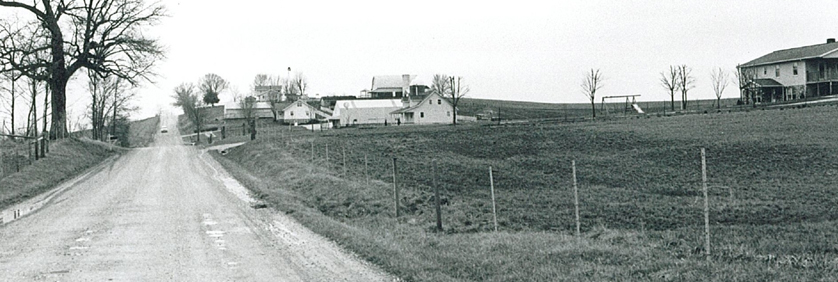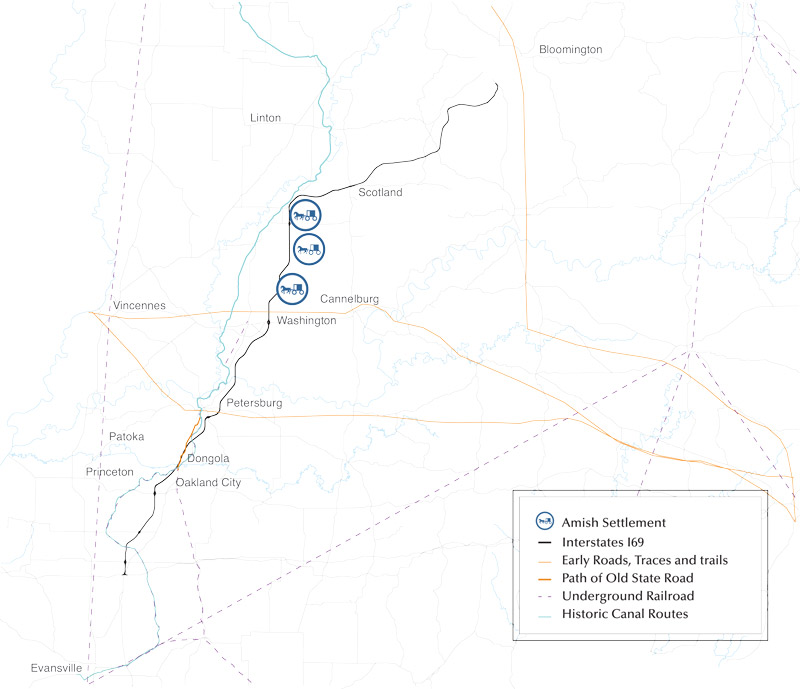As you travel I-69 between Crane and Washington, Indiana, you cross farm communities where horses are the main means of travel and farming, where windmills dot the landscape, and where laundry flaps in the wind both summer and winter. Between mile marker 68 and 72 is an area of Amish Settlement. "Amish Settlement" one of a series of vignettes that recounts the story of the land crossed by I-69 between I-64 and Bloomington, Indiana. Choose one or all of the vignettes to learn about the cultural and natural landscape as you Travel I-69.
The following narrative discloses the names of towns and interchanges where the Amish have lived and worked along our route and a map provides locational information. Observe towns along the route: Odon, Loogootee, Montgomery, and Washington.
More than a hundred years ago, a local newspaper, the Daviess County Democrat provided insight into community thoughts about the Amish:
"They are an economical sect of people and are great traders. They seldom pay cash for anything but always insist on trading farm products and poultry for what they want . . . They raise all the farm products usually grown in this section of the country and are said to be the most successful poultry raisers in the United States."
—Daviess County Democrat, October 2, 18971
- Read More

An Amish Lane in Daviess County, Indiana (Weintraut & Associates, Inc.)The Amish first moved to Southwestern Indiana just after the Civil War ended, in 1868 or 1869.[1] The journey had started in 1816 and continued until the 1860s, following a wave of religious persecution in Europe, when migrants came to the New World seeking to freely practice their faiths. Often they entered the United States on the East Coast and then traveled to the western frontier either by land or by boat.[2]
The nineteenth-century Amish probably looked similar to their neighbors, although they were set apart by their strict dedication to religious beliefs and practices. In established counties, the Amish purchased homes of the "English," a term they used for anyone who was not Amish. When the Amish did construct buildings, their homes and barns looked much like those of their neighbors.[3]
In the years following the Civil War, the Amish produced enough to provide for their families but purchased staples like sugar, salt, or spices at markets in Odon, Loogootee, Montgomery, and Washington. Farmers usually bartered surplus goods for supplies they needed.[4]
The Amish were united by religious beliefs but fellowship between the various Amish communities near Washington, Indiana, proved difficult. Poor roads common in rural areas inhibited communication. Like others, Amish traveled by foot, horse, or wagon to market. The buggy, the mode of transportation most associated with modern Amish, was rarely used in the nineteenth century because of the poor roads.[5]
The marked contrast between the Amish and the English came with the growth of mechanized farming and the widespread use of the automobile. Farms and the homes of the Old Order Amish, the most conservative of all Amish sects, began to look increasingly distinct as their neighbors adopted technologies, such as electricity, telephones, radio, and cars, while the Amish abstained.[6]
Even while abstaining from modern practices, however, the Old Order Amish adapted to the changing world. Farmers turned to dairy farming or vegetable gardens, commonly referred to as "truck gardens" since the produce was sold from the backs of trucks or, in the case of the Amish, from the backs of wagons. Some began taking contract work to supplement or provide income. Others turned their unique domestic skills into cottage industries, producing and selling quilts, doors, cabinets, and confections. Still others turned to the construction industry or the restaurant business.[7]
Today, the Old Order Amish of Southwestern Indiana continue to live among and do business with their English neighbors, operating restaurants and other businesses, maintaining farms, raising families, and worshiping, all while adhering to the religion’s tenets first advocated in seventeenth-century Europe. They provide a living and visible reminder of their faith, as they adhere to the Biblical saying: "They are not of the world, even as I am not of the world."
[1] Weintraut & Associates, Inc, “I-69: The Evansville to Indianapolis Study” Tier 1 Historic Context (Prepared for the Federal Highway Administration and Indiana Department of Transportation), 43.
[2] John A. Hostetler, Amish Society (Baltimore: The John Hopkins University Press, 1993), 65.
[3] Weintraut & Associates, Inc, “I-69 Corridor Tier 2 Studies Evansville to Indianapolis Historic Properties Report (HPR), Section 3, US 50 to US 231,” (Prepared for the Federal Highway Administration and Indiana Department of Transportation, 2005), 64.
[4] Joseph Stoll, “The Amish-Mennonites in Daviess County, Indiana” (Ontario, Canada: self-pub., 1959), 16.
[5] Stoll, “The Amish-Mennonites in Daviess County, Indiana,” 12.
[6] I-69 Corridor Tier 2, Section 3 HPR, 76.
[7] I-69 Corridor Tier 2, Section 3 HPR, 95-96.
Locations Of Amish Settlement

